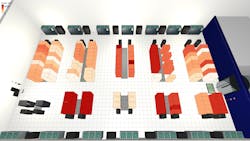How the Typical Data Center Life Cycle Exacerbates Power Fragmentation
According to the Uptime Institute’s 2022 Global Data Center Survey, outages are getting less frequent, but more expensive. On-site power issues are still the main cause of outages, with 44% of operators noting that power was the primary cause of their most recent impactful outage. While this problem isn’t necessarily new—power has consistently been cited as the largest cause of significant site outages since Uptime’s 2020 Survey—this issue will only get more severe as the maximum rack densities continue to rise. More than a third of data center operators said in the 2022 Survey that their rack densities have rapidly increased in the past three years. In short, outages are getting more expensive, power continues to play a major part, and the maximum rack densities are likely to increase moving forward.
In this post, I’ll differentiate the data center life cycle from the traditional product life cycle and highlight why this distinction matters with respect to power fragmentation and data center capacity.
The Data Center Life Cycle and Power Fragmentation
The traditional product life cycle has a clear distinction between design and operations. Once the design changes stop, the build process begins, followed by operation, and finally the end of support. The same cannot be said for the data center life cycle. While the data center life cycle can also be broken down into a design phase and an operational phase, the IT configuration changes from the initial design as soon as the data center becomes operational. These changes in IT continue throughout the data center’s lifespan. In this way, the data center is in a state of continuous redesign.
Power fragmentation becomes apparent during the operations stage as operators must accommodate IT with varying power densities. This fragmentation significantly impacts airflow and IT equipment temperatures. Take, for example, a 1200kW data center room design with an even distribution of 8.5kW per cabinet. The design layout initially allows for adequate cooling airflow to reach all IT equipment, keeping them within an acceptable temperature range at full capacity.
In the operational stage, IT will be deployed and decommissioned as the computing needs of the data center’s business counterpart change over time. Due to the heterogeneous nature of IT changes that happen, power will become unevenly distributed. This power fragmentation causes complex airflow and cooling issues with unforeseeable consequences.
Airflow interactions can have negative effects on the IT equipment temperatures that are invisible to the human eye. In this example, which we also outline in this video, 31.2% of IT equipment’s total power has become unavailable due to cooling and thermal issues caused by power fragmentation.
In a real-world scenario, temperature alerts and uncertainty around the impact of further changes would prevent this IT deployment. Thus, the data center can no longer accommodate new IT, and this power capacity is left stranded.
Stop Power Fragmentation Before It Starts
Never-ending IT changes lead to power fragmentation and eventually stranded capacity. These IT changes are a core part of the data center life cycle, so this issue isn’t going anywhere anytime soon. What if we could rectify these issues before fragmentation takes place? Thanks to physics-based data center simulation, it’s not only possible—it’s already happening.
Using a science-backed methodology to validate IT placement and, in turn, optimize the use of data center space is a surefire way to circumvent power fragmentation issues before they wreak havoc on your data center. Cadence’s data center simulation software provides helpful tools for both power and capacity management. When operators have a toolset that can assess capacity utilization and resource availability across a wide range of metrics, including power, they are better equipped to handle the unique challenges brought on by the data center life cycle.
Dave King is Senior Product Marketing Manager at Cadence Design Systems. Contact them to learn more.



